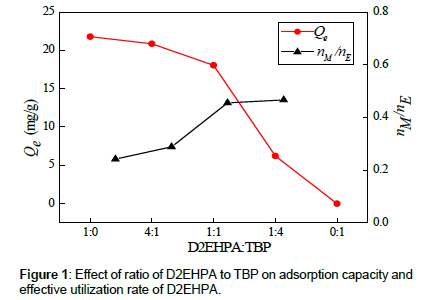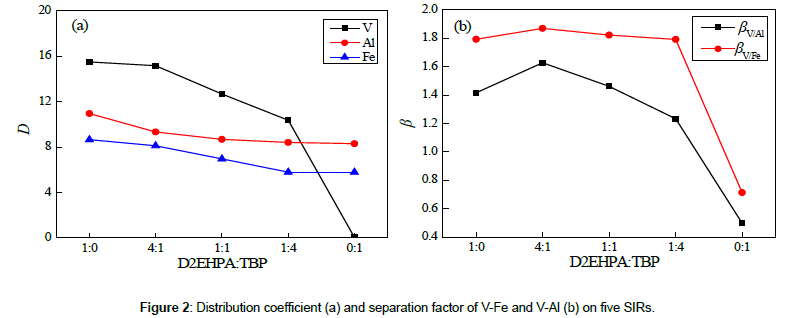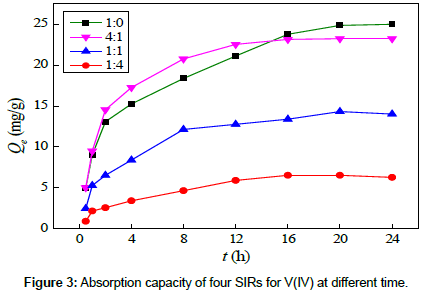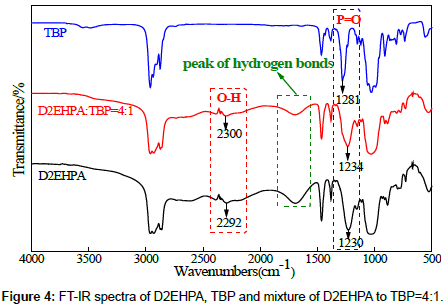Short Communication, J Chem Appl Chem Eng Vol: 2 Issue: 1
Adsorption of Vanadium (IV) on the Synthesized D2EHPA-TBP Impregnated Resin
Shenxu Bao1*, Ruwei Zheng1, Yimin Zhang1,2 and Bo Chen1
1School of Resources and Environmental Engineering, Wuhan University of Technology, Wuhan, 430070, China
2College of Resources and Environmental Engineering, Wuhan University of Science and Technology, Wuhan, 430081, China
*Corresponding Author : S. Bao
School of Resources and Environmental Engineering, Wuhan University of Technology, Wuhan, 430070, China
E-mail: sxbao@whut.edu.cn
Received: February 28, 2018 Accepted: March 27, 2018 Published: April 09, 2018
Citation: Bao S, Zheng R, Zhang Y, Chen B (2018) Adsorption of Vanadium (IV) on the Synthesized D2EHPA-TBP Impregnated Resin. J Chem Appl Chem Eng 2:1. doi: 10.4172/2576-3954.1000114
Abstract
Solvent impregnated resins (SIRs) were synthesized by impregnating Amberlite XAD-16HP with the mixing extractants with (Di-(2-ethylhexyl)phosphoric acid (D2EHPA) to TBP (Tributyl phosphate) ratios of 1:0, 4:1, 1:1, 1:4 and 0:1. The adsorption capacity of D2EHPA-TBP impregnated resin (DTIR) for V(IV) decreases with the increasing content of TBP because TBP do not adsorb V(IV). However, TBP can allow D2EHPA to be distributed more homogenously and uniformly in the pores of SIR. Thus, the effective utilization rate of D2EHPA increases with the increasing TBP. Among the ratios of D2EHPA to TBP studied, 4:1 is the most appropriate one for preparing SIRs. The DTIR with D2EHPA to TBP ratio of 4:1 presents the highest separation factor of V(IV) to Fe(II) and V(IV) to Al(III) than other DTIRs. Moreover, TBP also can break the hydrogen bonds in the D2EHPA dimers and convert part of D2EHPA dimers to the monomers, which may accelerate the adsorption of V(IV) on the DTIR.
Keywords: Impregnated resin; Vanadium; Adsorption; Kinetics; Separation
Introduction
Vanadium (V) is an important rare element with unique and excellent physical and chemical properties, which is widely used in alloys, catalyst and vanadium redox battery [1,2]. Acid leaching is an effective method to recover vanadium from the vanadium-bearing resources, such as stone coal, spent catalysts and fly ash, for its high leaching efficiency and low energy consumption [3,4]. However, many undesirable impurities are commonly dissolved in the acid leaching solution together with vanadium, which makes the separation and recovery of vanadium from the complex leaching solution become a necessary process for the extraction flowchart of V2O5 [5,6].
Solvent impregnated resin (SIR) is one type of novel adsorbent which is synthesized by incorporating extractant into macroporous resin. It combines the advantages of ion exchange and solvent extraction and has got more attention in separation and recovery of vanadium on account of its good selectivity, easy operability and environmental friendliness [7]. Di-(2-ethylhexyl)phosphoric acid (D2EHPA) is a widely used extractant for separation of V(IV) in solvent extraction [8]. Some researchers have synthesized D2EHPA-impregnated resin (DIR) and used it for recovery of V(IV) [9,10]. In the solvent extraction process for extracting V(IV), Tributyl phosphate (TBP) are commonly used with D2EHPA together to enhance the separation effect of V(IV) from the leaching solution [11]. However, rare literatures have been published for reporting the adsorption of V(IV) on the DIR incorporating TBP. In this work, we synthesized the D2EHPA-TBP impregnated resins (DTIRs) by impregnating support resin with different D2EHPA-TBP mixtures and probed the adsorption characteristics of V(IV) on the DTIRs.
Materials and Methods
Materials
Macroporous resin, Amberlite® XAD-16HP, supplied by Shanghai Anland Co., Ltd., China, was used as the support for the preparation of DTIRs. The matrix of XAD-16HP is poly (styrene-divinylbenzene) and its mean pore diameter is ca. 8.66 nm [10]. The resin was washed by ethanol and deionized water, and then dried at 60°C before use.
D2EHPA, TBP and petroleum ether were purchased from Sinopharm Chemical Reagent Co., Ltd., China.
The simulated vanadium leaching solution containing 1500 mg/L V(IV), 4000 mg/L Fe(II) and 6000 mg/L Al(III) was prepared by dissolving VOSO4·xH2O, FeSO4·7H2O and Al2(SO4)3·18H2O in deionized water. The pure vanadium solution containing 1500 mg/L V(IV) was prepared by only dissolving VOSO4·xH2O in deionized water. The pH of the solutions was adjusted by sulfuric acid with A.R. grade. All chemicals used in this study were of analytical grade.
The vanadium concentration was determined by ferrous ammonium sulfate titration using 2-(phenylamino)-benzoic acid as indicator and the concentrations of other ions in solution were analyzed by inductively coupled plasma–optical emission spectroscopy (ICP-OES) (Optima 4300DV, Perkin–Elmer, USA). pH of the solution was measured by pHS-3C digital pH meter (INESA Scientific Instrument Co., Ltd, China). Fourier Transform Infrared Spectra (FT-IR) spectra of SIRs were recorded on a Nicolet 6700 spectrometer (Thermo Fisher Scientific Co., Waltham, MA, USA).
Preparation of SIR
Petroleum ether with boiling point range of 60-90°C was used to dilute D2EHPA and TBP. The impregnation process was same to that described [9]. Briefly, Dry XAD-16HP (1.00 g) were immersed in 20 mL diluted mixture of D2EHPA and TBP (50% v/v), which was shaken for 24 h at 298 K. Then the resins were separated and washed with deionized water. Finally, the SIRs were obtained by heating the resins at 60°C for 12 h.
V(IV) adsorption experiments
0.5 g DTIRs were added to 25 mL pure vanadium or simulated vanadium leaching solutions in a conical flask, then the mixture was shaken (160 rpm) at a bath oscillator at 25°C for different contacting time. Subsequently, the mixture was filtrated. The adsorption capacity of SIRs for V(IV), (Q (mg·g-1)), the distribution coefficient (D), separation factor (β) and the effective utilization rate of D2EHPA (nM/ nE) were calculated by Eq. (1), Eq. (2), Eq. (3) and Eq. (4), respectively.
 (1)
(1)
 (2)
(2)
 (3)
(3)
 (4)
(4)
where V is the volume of V(IV) solutions (L), C0 and Ce are initial and equilibrium concentration of V(IV) in the solutions (mg·L-1) respectively, and m is the weight of the dry SIRs (g). βA/B represents the separation factor of ion A to B. DA and DB are the distribution coefficients of V(IV) and impurity ion between SIRs and solution, respectively. nM represents the moles of adsorbed V(IV) and nE indicates the moles of D2EHPA impregnated in SIRs. nv and nD2EHPA are the molecular weight of vanadium and D2EHPA, respectively, η is the content of mixed extractant in SIR, α is the content of D2EHPA in the mixed extractant.
Results and Discussion
Adsorption capacity and effective utilization rate of D2EHPA
The adsorption capacity of different SIRs for V(IV) after 20 h at pH=2.0 is shown in Figure 1. It shows that the adsorption capacity sharply declines with the decreasing proportion of D2EHPA in the mixture of D2EHPA and TBP. In the absence of D2EHPA, the SIR has no adsorption capacity for V(IV), indicating TBP do not adsorb V(IV). However, the effective utilization rate of D2EHPA increases with the decrease of D2EHPA content. It is known that the viscosity TBP is lower than that of D2EHPA, thus, the solvent may be distributed more homogenously and uniformly in the pores of the support resin after the addition of TBP, and more D2EHPA can react with V(IV), resulting in the increase of the effective utilization rate of D2EHPA (Figure 1).
Separation of V(IV) from impurity ions
The distribution coefficient of V(IV), Fe(II) and Al(III) and βV/Fe and βV/Al on different SIRs are shown in Figure 2. It can be seen that D2EHPA has high affinity for V(IV) than for Fe(II) and Al(III), thus the distribution coefficient of V(IV) on the DIR are higher than that on other SIRs in Figure 2. The distribution coefficient of V(IV) on the SIRs decreases with the increase of the proportion of TBP and it declines to zero on the TBP impregnated resin because TBP do not adsorb V(IV) (Figure 2a). Furthermore, it also can be seen that both βV/Fe and βV/Al firstly increase and then decline with the increasing proportion of TBP. βV/Fe and βV/Al reach the peak on the DTIR with the ratio of D2EHPA to TBP = 4:1, suggesting that the appropriate TBP in the solvent can enhance the separation of V(IV) from the leaching solution.
Adsorption kinetics
The adsorption capacities of different SIRs for V(IV) at different time are shown in Figure 3. The DTIRs with D2EHPA:TBP = 4:1 and 1:0 exhibit apparently higher adsorption capacity for V(IV) than other DTIRs, indicating that the adsorption capacity for V(IV) is closely related with the content of D2EHPA in the SIRs. Theoretically, the adsorption capacity of DTIRs with D2EHPA:TBP = 4:1 for V(IV) should be lower than that with D2EHPA:TBP = 1:0 because the former has lower DE2HPA content than the later. However, by comparing the capacity of the two DTIRs for V(IV), the DTIR with D2EHPA:TBP = 4:1 has higher adsorption capacity than the resin with D2EHPA:TBP = 1:0 at 12h (Figure 3), indicating that the mass transfer of V(IV) in the former is faster than in the later. As the reaction time is extended to reach equilibrium, the adsorption capacity of DTIR with D2EHPA:TBP = 1:0 then exceeds that of the SIR with D2EHPA:TBP = 4:1 due to the higher D2EHPA content.
The shrinking core model [12], which may be controlled by fluid film diffusion, intraparticle diffusion and chemical reaction, listed as Eq. (5), Eq.(6), and Eq. (7) respectively, are used to describe the adsorption of V(IV) on the DTIRs.
 (5)
(5)
 (6)
(6)
 (7)
(7)
In these equations, F is the exchange fraction, C0 is the concentration of V(IV) in bulk solution(mg/L), Kf is the mass transfer coefficient of V(IV) through the liquid film (m s–1), R is the radius of the resin bead (mm), De is the effective diffusion coefficient of V(IV) in resin beads in Particle diffusion control, Ke is the rate constant of chemical reaction (m s‑1).
The fitting results and parameters of these equations are shown in Table 1. The fitting results indicate that the adsorption of V(IV) on all DTIRs are controlled by intraparticle diffusion, which is consistent with the adsorption of most metals on ion exchange resin [12].
| D2EHPA:TBP | R2 | De | ||
|---|---|---|---|---|
| Fluid film control | Intraparticle diffusion control | Chemical reaction control | ||
| 1:0 | 0.8796 | 0.9429 | 0.8796 | 0.0551 |
| 4:1 | 0.7690 | 0.9901 | 0.7690 | 0.0881 |
| 1:1 | 0.8817 | 0.9797 | 0.8817 | 0.0407 |
| 1:4 | 0.9294 | 0.9899 | 0.9294 | 0.0175 |
Table 1: The fitting results of the shrinking core model for the adsorption of V(IV) on different SIRs
The calculated De for the DTIR with D2EHPA:TBP = 4:1 is 0.0881, which is higher than those for other DTIRs. This also verifies that the mass transfer of V(IV) is the fastest in the DTIR with D2EHPA:TBP = 4:1 (see Figure 3). Thus, TBP can accelerate the reaction between D2EHPA and V(IV) in the resins. With the increase of TBP content, the adsorption capacity of DTIRs for V(IV) declines sharply and then this also causes the decrease of De.
FT-IR analysis
In the FT-IR spectrum of D2EHPA (Figure 4), the peaks at 2292 and 1230 cm-1, which are assigned to the stretching vibration of O-H and P=O, respectivly [13,14] can be seen. The 1281 cm-1 peak in TBP spectrum is assigned to the stretching vibration of P=O. It can be seen that the peak of P=O shifs from 1281 cm-1 to the low wavenumber 1230 cm-1 in D2EHPA due to the formation hydrogen bonds [15]. D2EHPA genrally exits as dimers by hydrogen bonds which also can be seen in the FT-IR spectum (Figure 4). As TBP is added, it can be seen that the stretching vibration of O-H and P=O in D2EHPA shifts to the higher avenumbers, indicating that part D2EHPA may be converted from dimers to monomers due to the break of hydrogen bonds. This also can be verified by the weakening of the peak of hydrogeon bonds in the dimers (Figure 4). D2EHPA can provide more reacting sites for adsorbing V(IV) when it is changed from dimers to monomers and then the adsorption of V(IV) on the DTIR can be accelerated.
Conclusions
The adsorption capacity of DTIR for V(IV) decreases with the increasing content of TBP in the DTIR because TBP do not adsorb V(IV). However, as the increasing of TBP, the effective utilization rate of D2EHPA increases, indicating that TBP can make D2EHPA to be distributed more homogenously and uniformly in the pores of SIR. The DTIR with D2EHPA to TBP ratio of 4:1 is the most appropriate one for the separation of V(IV) from Fe(II) and Al(III) in this study. Moreover, the adsorption of V(IV) on the DTIR with D2EHPA to TBP ratio of 4:1 is faster than that on the D2EHPA impregnated resin. This may be caused by the fact that part D2EPHA can be changed from dimers to monomers by adding TBP, which provides more reacting sites for V(IV) and accelerates the adsorption process.
Acknowledgement
This research was supported by the Fundamental Research Funds for the Central Universities (WUT: 2017II34GX).
References
- Moskalyk RR, Alfantazi AM (2003) Processing of vanadium: a review. Miner Eng 16: 793-805.
- Zhang Y M, Bao S X, Liu T (2011) The technology of extracting vanadium from stone coal in China: History, current status and future prospects. Hydrometallurgy 109: 116-124.
- Zhang Y, Zhu X, Liu T, Huang J, Song S (2013) Effect of colloidal potassium alum formation on vanadium recovery from acid leach solutions of stone coal. Hydrometallurgy 138: 54-58.
- Li M, Wei C, Qiu S, Zhou X, Li C, et al. (2010) Kinetics of vanadium dissolution from black shale in pressure acid leaching. Hydrometallurgy 104: 193-200.
- Li W, Zhang Y, Liu T, Huang J, Wang Y (2013) Comparison of ion exchange and solvent extraction in recovering vanadium from sulfuric acid leach solutions of stone coal. Hydrometallurgy 131-132: 1-7.
- Yang X, Zhang Y, Bao S, Shen C (2016) Separation and recovery of vanadium from a sulfuric-acid leaching solution of stone coal by solvent extraction using trialkylamine. Sep Purif Technol 164: 49-55.
- Bao S, Tang Y, Zhang Y (2016) Recovery and Separation of Metal Ions from Aqueous Solutions by Solventâ€ÂImpregnated Resins. Chem Eng Technol 39: 1377-1392.
- Hu J, Zhu Y (2017) Extraction of Vanadium by P204 from Sulfuric Acid Solution. Chinese Journal of Rare Metals 31: 367-370
- Liang L, Bao S, Zhang Y, Yongping T (2016) Separation and recovery of V(IV) from sulfuric acid solutions containing Fe(III) and Al(III) using bis(2-ethylhexyl)phosphoric acid impregnated resin. Chem Eng Res Des 111: 109-116.
- Tang Y, Bao S, Zhang Y, Liang l (2017) Effect of support properties on preparation process and adsorption performances of solvent impregnated resins. React Funct Polym 113: 50-57.
- Li X, Deng Z, Wei C, Li C, Li M, et al. (2015) Solvent extraction of vanadium from a stone coal acidic leach solution using D2EHPA/TBP: Continuous testing. Hydrometallurgy 154: 40-46.
- Cortina JL, Miralles N (1997) Kinetic studies on heavy metal ions removal by impregnated resins containing Di-(2,4,4-Trymethylpentyl) Phosphinic Acid. Solvent Extr Ion Exch 15: 1067-1083.
- Shi Q, Zhang Y, Huang J, Liu T, Liu H, et al. (2017) Synergistic solvent extraction of vanadium from leaching solution of stone coal using D2EHPA and PC88A. Sep Purif Technol 181: 1-7.
- Zhang F, Dai J, Wang A, Wu W (2017) Investigation of the synergistic extraction behavior between cerium (III) and two acidic organophosphorus extractants using FT-IR, NMR and mass spectrometry. Inorg Chim Acta 466: 333-342.
- Griffiths PR, de Haseth JA (1986) Fourier transform infrared spectrometry. Wiley, New York, USA, 297-302.
 Spanish
Spanish  Chinese
Chinese  Russian
Russian  German
German  French
French  Japanese
Japanese  Portuguese
Portuguese  Hindi
Hindi 



